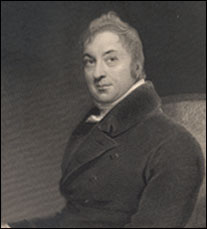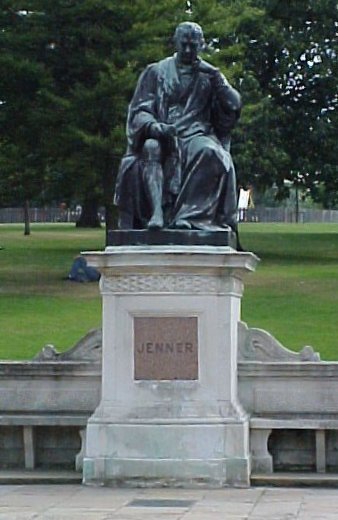<Back to Index>
- Surgeon and Anatomist Edward Anthony Jenner, 1749
- Painter Alessandro di Mariano di Vanni Filipepi (Sandro Botticelli), 1445
- King of Spain Alfonso XIII, 1886


Edward Anthony Jenner (17 May 1749 – 26 January 1823) was an English scientist who studied his natural surroundings in Berkeley, Gloucestershire. Jenner is widely credited as the pioneer of smallpox vaccine, and is sometimes referred to as the 'Father of Immunology'. Jenner's discovery 'has saved more lives than the work of any other man'.
Edward Jenner was born on 17 May 1749 in Berkeley. Jenner then trained in Chipping Sodbury, Gloucestershire, as an apprentice to Daniel Ludlow, a surgeon, for eight years from the age of 14. In 1770 Jenner went up to surgery and anatomy under the surgeon John Hunter and others at St George's Hospital. William Osler records that Jenner was a student to whom Hunter repeated William Harvey's advice, very famous in medical circles (and characteristically Enlightenment), "Don't think, try". Jenner therefore was early noticed by men famous for advancing the practice and institutions of surgery. Hunter remained in correspondence with him over natural history and proposed him for the Royal Society. Returning to his native countryside by 1773 he became a successful general practitioner and surgeon, practising in purpose-built premises at Berkeley.
Jenner and others formed a medical society in Rodborough, Gloucestershire, meeting to read papers on medical subjects and dine together. Jenner contributed papers on angina. In this time smallpox was
greatly feared, as one in three of those who contracted the disease
died, and those who survived were often badly disfigured. Lady Mary Wortley Montagu discovered the Ottoman Empire concept of variolation during her 1716-1718 stint in Istanbul, and brought the idea back to Britain. Voltaire,
a few years later, recorded that 60% of people caught smallpox, with
20% of the population dying of it. In the years following 1770 there
were at least six people in England and Germany (Sevel, Jensen, Jesty
1774, Rendell, Plett 1791) who had successfully tested the possibility
of using the cowpox vaccine as an immunization for smallpox in humans. For example, Dorset farmer Benjamin Jesty had successfully vaccinated and presumably induced immunity in
his wife and two children with cowpox during a smallpox epidemic in
1774, but it was not until Jenner's work some twenty years later that
the procedure became widely understood. Indeed it is generally believed
that Jenner was unaware of Jesty's success and arrived at his
conclusions independently.
Noting
the common observation that milkmaids did not generally get smallpox,
Jenner theorized that the pus in the blisters which milkmaids received
from cowpox (a
disease similar to smallpox, but much less virulent) protected the
milkmaids from smallpox. He may have had the advantage of hearing stories of Benjamin Jesty and
others who deliberately arranged cowpox infection of their families,
and then noticed a reduced smallpox risk in those families. On 14 May 1796, Jenner tested his theory by inoculating James Phipps,
a young boy of 8 years, with material from the cowpox blisters of the
hand of Sarah Nelmes, a milkmaid who had caught cowpox from a cow
called Blossom, whose
hide hangs on the wall of the library at St George's medical school
(now in Tooting). Blossom's hide commemorates one of the school's most
renowned alumni. Phipps was the 17th case described in Jenner's first
paper on vaccination. Jenner
inoculated Phipps with cowpox pus in both arms on the same day. The
inoculation was accomplished by scraping the pus from Nelmes' blisters
onto a piece of wood then transferring this to Phipps' arms. This
produced a fever and some uneasiness but no great illness. Later, he
injected Phipps with variolous material,
which would have been the routine attempt to produce immunity at that
time. No disease followed. Jenner reported that later the boy was again
challenged with variolous material and again showed no sign of
infection. Jenner's unique contribution was not that he
inoculated a few persons with cowpox, but that he then proved they were
immune to smallpox. Moreover, he demonstrated that the protective
cowpox could be effectively inoculated from person to person, not just
directly from cattle. In
addition he tested his theory on a series of 23 subjects. This aspect
of his research method increased the validity of his evidence. He
continued his research and reported it to the Royal Society, who did
not publish the initial report. After improvement and further work, he
published a report of twenty-three cases. Some of his conclusions were
correct, and some erroneous – modern microbiological and
microscopic methods would make this easier to repeat. The medical
establishment, as cautious then as now, considered his findings for
some time before accepting them. Eventually vaccination was accepted,
and in 1840 the British government banned variolation – the use of
smallpox itself – and provided vaccination – using
cowpox – free of charge. Jenner's
continuing work on vaccination prevented his continuing his ordinary
medical practice. He was supported by his colleagues and the King in
petitioning Parliament and was granted £10,000 for his work on
vaccination. In 1806 he was granted another £20,000 for his
continuing work. In 1803 in London he became involved with the Jennerian Institution, a society concerned with promoting vaccination to eradicate smallpox.
In 1808, with government aid, this society became the National Vaccine
Establishment. Jenner became a member of the Medical and Chirurgical
Society on its foundation in 1805, and subsequently presented to them a
number of papers. This is now the Royal Society of Medicine. In 1806, he was elected a foreign member of the Royal Swedish Academy of Sciences. Returning
to London in 1811 he observed a significant number of cases of smallpox
after vaccination occurring. He found that in these cases the severity
of the illness was notably diminished by the previous vaccination. In
1821 he was appointed Physician Extraordinary to King George IV,
a considerable national honour, and was made Mayor of Berkeley and
Justice of the Peace. He continued his interests in natural history. In
1823, the last year of his life, he presented his Observations on the Migration of Birds to the Royal Society. Jenner was found in a state of apoplexy on
25 January 1823, with his right side paralysed. He never fully
recovered, and eventually died of an apparent stroke (he had suffered a
previous stroke) on 26 January 1823, aged 73. He was survived by one
son and one daughter, his elder son having died of tuberculosis at the
age of 21. In 1979, the World Health Organization declared
smallpox an eradicated disease. This was the result of coordinated
public health efforts by many people, but vaccination was an essential
component. And although it was declared eradicated, some samples still remain in laboratories in Centers for Disease Control and Prevention (CDC) in Atlanta, Georgia, in the United States, and State Research Center of Virology and Biotechnology VECTOR in Koltsovo, Novosibirsk Oblast, Russia.